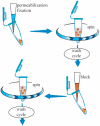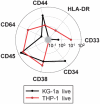Development of analytical methods for multiplex bio-assay with inductively coupled plasma mass spectrometry
- PMID: 19122859
- PMCID: PMC2600572
- DOI: 10.1039/b710510j
Development of analytical methods for multiplex bio-assay with inductively coupled plasma mass spectrometry
Abstract
Advances in the development of highly multiplexed bio-analytical assays with inductively coupled plasma mass spectrometry (ICP-MS) detection are discussed. Use of novel reagents specifically designed for immunological methods utilizing elemental analysis is presented. The major steps of method development, including selection of elements for tags, validation of tagged reagents, and examples of multiplexed assays, are considered in detail. The paper further describes experimental protocols for elemental tagging of antibodies, immunostaining of live and fixed human leukemia cells, and preparation of samples for ICP-MS analysis. Quantitative analysis of surface antigens on model cell lines using a cocktail of seven lanthanide labeled antibodies demonstrated high specificity and concordance with conventional immunophenotyping.
Figures





References
-
- Unwin RD, Evans CA, Whetton AD. Trends Biochem. Sci. 2006;31:473–84. - PubMed
-
- Ornatsky O, Baranov V, Bandura DR, Tanner SD, Dick J. J. Immunol. Methods. 2006;308:68–76. - PubMed
-
- Careri M, Elviri L, Mangia A, Mucchino C. Anal. Bioanal. Chem. 2007;387:1851–54. - PubMed
-
- Hu SH, Zhang SC, Hu ZC, Xing Z, Zhang XR. Anal. Chem. 2007;79:923–29. - PubMed
Grants and funding
LinkOut - more resources
Full Text Sources
Other Literature Sources
